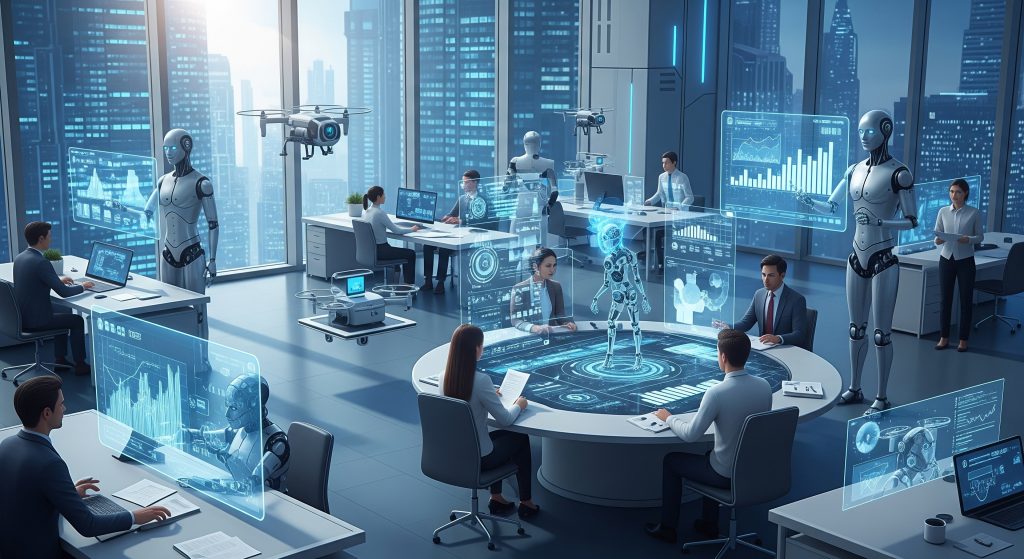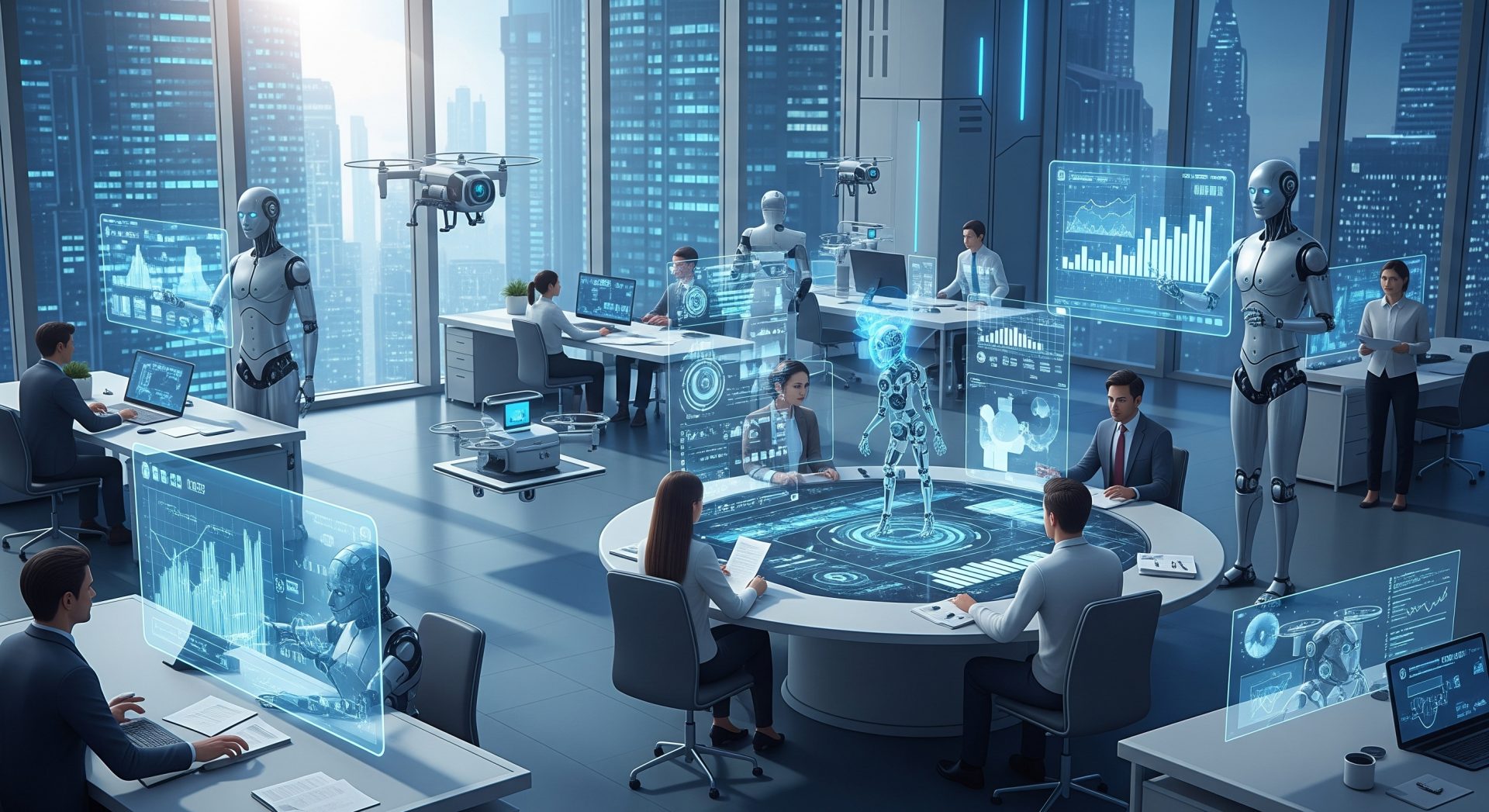In today’s fast-paced digital world, businesses face constant pressure to do more with less. Many organizations find themselves bogged down by manual tasks and legacy processes while competitors race ahead with AI-driven innovation. Autonomous AI agents — intelligent software tools that can plan, decide, and act independently — are emerging as a powerful answer. These “digital assistants” can handle complex, multi-step workflows (from scheduling and data entry to generating reports and insights) with minimal human direction. The result is streamlined operations and empowered employees. Recent surveys report that about 85% of organizations have already integrated AI agents into at least one workflow. This surge in AI-agent adoption reflects a shift toward goal-driven automation, where software does more than follow static rules — it adapts and learns. For leaders in tech-intensive fields, understanding how to leverage autonomous AI agents is now a strategic priority.
AI agents are already automating routine work across industries. By combining natural language processing, planning algorithms, and data integration, these agents can, for example, sift through emails, generate meeting summaries, or even reconcile financial statements automatically. In sectors such as finance and healthcare, agents analyze data streams in real-time to detect fraud or prioritize patient care. In customer service and marketing, agents provide personalized recommendations and handle inquiries 24/7, freeing human teams to focus on strategy and creative tasks. Leading technology firms note that nearly 70% of Fortune 500 companies already use AI copilots and assistants (like Microsoft 365 Copilot) to tackle mundane tasks such as email triage and note-taking. Looking ahead, new generations of AI agents will assume even more responsibility, autonomously handling predefined tasks on behalf of users. This is the “new apps” era: instead of launching a new software for each process, businesses are embedding intelligent agents that work across apps and systems, boosting overall efficiency.
Understanding Autonomous AI Agents
What exactly is an AI agent? In simple terms, it’s software that not only processes inputs but also makes decisions based on goals and changing information. Unlike traditional RPA (robotic process automation) tools that rigidly follow pre-set rules, or chatbots that only respond to specific queries, autonomous AI agents can plan, reason, and act. They often rely on large language models (LLMs) and machine learning to interpret context. For instance, an agent might review a report, identify key issues, and then update a project management tool without step-by-step instructions. As one Gartner analyst puts it, “Agentic AI eliminates the need to interact with websites and applications. Why bother when your AI agent can do it for you?”. In practice, agents can range from simple task-helpers (like a script that auto-schedules meetings from an email prompt) to fully autonomous systems that use external APIs, memory, and even collaborate with other agents to complete complex workflows. They effectively become “goal-driven digital workers” embedded in enterprise processes.

Agents come in various types (reactive, goal-based, learning agents, etc.), but a defining feature is adaptability. They monitor outcomes, ask for help if stuck, and improve over time. For example, an agentic code generator might learn a developer’s style, whereas a financial agent learns industry trends to better allocate investments. In essence, autonomous AI agents extend the traditional workforce by taking over repeatable tasks and basic decision loops. They don’t replace humans; instead, they free people for higher-value work. 87% of surveyed decision-makers agree that AI agents augment existing roles rather than replace them.
The Surge in Adoption: Trends and Statistics
AI agents have rapidly moved from experimental pilots to core business tools. A KPMG report notes that 85% of organizations have begun implementing AI into operations, with many focusing on workforce planning and management use cases. Similarly, industry surveys find that over half of companies already have agents in production, and many more are on the way. One LangChain survey of 1,300 professionals in 2024 found that 51% of companies have AI agents running in production today, and a further 78% plan to deploy them soon. By 2025, Deloitte predicts that one-quarter of companies using generative AI will launch formal agentic AI pilots, rising to 50% by 2027. These trends hold across company sizes and regions — for example, 90% of non-tech firms surveyed are either using or planning AI agents.
Industry analysts anticipate this adoption accelerating. According to Gartner’s strategic tech trends, less than 1% of enterprise applications had agentic AI in 2024, but this is expected to jump to one-third by 2028. That means a massive shift toward AI-powered workflows is coming. As AI models become more capable, agents will handle larger chunks of work: Gartner also forecasts that by 2028, 20% of digital storefront interactions will be managed by AI agents and 15% of day-to-day decisions made autonomously. Businesses are eager to capture these productivity gains. The global AI-agent market is booming too: it grew from about $3.7 billion in 2023 to an estimated $7.4 billion by 2025, with a CAGR of over 45% toward an $100+ billion industry by 2032. All these points point to a new normal where autonomous AI agents become as commonplace as traditional software tools.
AI Agents in Action: Real-World Use Cases
Autonomous agents are already delivering real business impact. The possibilities span virtually every industry:
- Customer Support & Service: AI agents can autonomously handle routine queries and triage tickets. Unlike basic chatbots, agentic assistants continuously improve by learning from past interactions. For instance, agentic AI systems can proactively flag customer issues or even execute solutions — like issuing refunds or scheduling callbacks — without a human having to intervene. This leads to faster resolutions and lower support costs. One study notes customer service agents are often the first place autonomous agents prove their value by “improving responses over time and recalling relevant customer data in real time,”.
- Sales and Marketing: Marketing agents analyze campaign data in real time to optimize ads and content. They build customer personas, schedule email blasts at optimal times, and personalize offers. For example, agentic tools can scour social media to monitor brand mentions and automatically engage users. AI-driven agents in sales can score leads, predict buyer intent, and even conduct personalized outreach (via email, chat, or voice) to interested prospects. They integrate with CRM systems to fetch customer histories and suggest next-best actions. This hands-off approach has enabled some teams to nurture leads at scale. An aerospace example: NASA developed an AI agent for its Jet Propulsion Laboratory engineers; the agent understands robotics code and can diagnose issues or run simulations based on natural language prompts, freeing engineers to focus on higher-level design.
- Finance and Banking: In fast-moving financial environments, agentic AI provides continuous monitoring and analysis. Autonomous agents perform tasks like real-time risk audits, scanning transaction patterns for fraud, and taking immediate action. They can also automate compliance workflows (e.g,. anti-money laundering checks) and loan processing. On the client-facing side, some banks use AI agents as robo-advisors — crafting personalized investment strategies or managing wealth portfolios based on live market data. These agents act like junior analysts 24/7, spotting trends humans might miss and optimizing the portfolio on the fly.
- Healthcare and Life Sciences: Healthcare facilities are using AI agents to trim administrative overhead. Agents can autonomously schedule patient appointments, handle billing and insurance claims, and even manage prior authorizations – tasks that traditionally bog down staff. For instance, with access to patient records, an AI agent can process routine paperwork faster than a human clerk. On the clinical side, agentic systems sift through medical literature and patient data to suggest diagnoses or treatment plans, alerting providers to high-risk cases earlier. Hospitals can therefore reallocate staff toward direct patient care. According to industry experts, these AI “digital nurses” can reduce clerical burdens and improve response times in critical care settings.
- Human Resources & Internal Ops: Internally, businesses use AI agents to support employees and HR staff. For example, IBM’s internal tool “AskHR” is an AI agent that fully automates over 80 common HR queries (leave requests, benefit info, etc.), freeing HR teams to focus on strategic initiatives. Onboarding can be personalized by agents who guide new hires through training schedules and paperwork. Across IT operations, autonomic agents monitor system health and intervene (reboot servers, reroute traffic) without waiting for human alerts. Even software development benefits: coding agents like GitHub Copilot are a form of AI agent that autocomplete and generate code, boosting developer productivity significantly (developers using such tools report productivity jumps from 15% up to 100%+ in certain tasks).
These examples illustrate the breadth of agentic AI’s impact. By automating data-heavy, multi-step tasks in finance, healthcare, marketing, HR, and more, AI agents are driving measurable improvements: lower costs, faster service, and higher output quality. As IBM notes, leaders are already integrating these “digital workers” into their operations to streamline customer support, optimize supply chains, and analyze data across industries.
Benefits vs. Challenges: Productivity with a Human Touch
The appeal of autonomous agents lies in their productivity gains. By running 24/7 without breaks and scaling effortlessly across tasks, they boost efficiency and speed. Companies report dramatic results: some case studies show up to 80% reduction in support costs and 90% faster handling times after deploying AI agent systems (figures from recent AI agent surveys). Enterprises also gain agility — agents can be quickly re-tasked to new objectives via simple prompt updates, versus the weeks of development needed for traditional software changes. In the global market, firms leveraging AI agents are seeing accelerated ROI on their digital transformation investments.
However, adopting autonomous agents comes with new considerations. Trust and control remain paramount. Most businesses are taking a measured approach: a recent industry survey found that around 71% of users prefer a human to review or approve an AI agent’s output, especially for important or sensitive tasks. This reflects a common theme: while agents can make decisions, companies are building in oversight by default. Poor data quality or lack of documentation led to trouble with earlier RPA programs, and leaders want to avoid repeating those mistakes. In practice, successful deployments often include human-in-the-loop checks (e.g., managers approve agent recommendations) or at least human-on-the-loop monitoring with real-time logs and alerts.
According to Deloitte, many early agent pilots struggle to move into full production — fewer than one-third of generative AI pilots make it to scale. Common hurdles include data silos, unclear business processes, and change management. Therefore, businesses must plan carefully. Critical best practices include starting with low-risk use cases, iterating quickly, and maintaining transparency in how the agent makes decisions. Multimodal checks like audit trails and design patterns such as “fail-safes” (where an agent asks for human help if uncertain), are now standard. For example, an enterprise might restrict an agent’s permissions to “read-only” in critical systems, as many companies do, enabling full actions only after human approval.
In short, the future is not “AI vs. humans,” but AI with humans. The trend is clear: agents take on the execution of routine tasks, while people handle exceptions, strategy, and ethics. Companies retool jobs: AI specialists and “AI workflow architects” design and supervise agents, while business staff focus on creative and relational work. About 87% of tech leaders agree that AI agents augment rather than replace existing roles. This collaborative paradigm boosts morale and retention — employees spend more time on interesting problems and let the agents handle the heavy lifting.
Making It Happen: Implementation and Partnerships
How can decision-makers harness this potential? First, businesses need to view agentic AI as an enterprise-wide transformation, not just another pilot. Successful adoption often starts by identifying high-impact processes: for instance, invoicing, customer inquiries, or data reconciliation – tasks with high volume and clear rules. Then, assembling the right technology stack is crucial. This might involve integrating LLMs (like GPT-5 or Claude 3) with workflow tools and API-based orchestration (using frameworks like LangChain, AutoGen, or enterprise AI platforms). The market already offers many agent frameworks and no-code builders, but companies still need developer talent to customize them.
This is where tech partners like DigiEx Group can add value. With decades of global IT experience, our team brings proven expertise in AI-driven software development and scaling remote teams. For example, our team can help design a human-centric agent architecture: data engineers set up the information pipelines, AI specialists tune the models, and DevOps ensure security and uptime. Because DigiEx Group operates in Vietnam — a tech hub with a strong engineering talent pool — clients also benefit from nearshore cost advantages and around-the-clock development coverage. Many of our clients (especially in Western Europe, the US, and Australia) leverage the company’s Vietnam-based R&D teams to rapidly build and iterate AI solutions.
Key steps include partnering with experts to map current workflows, then co-creating agents with iterative feedback loops. Our approach often involves user-testing prototypes (e.g., in customer service or HR) to fine-tune agent behavior before full rollout. They also emphasize human oversight by building in monitoring dashboards and alert systems. In this way, a human supervisor can see what an agent is doing in real time and intervene if needed. Training and change management are part of the solution: DigiEx Group’s consultants work with client teams to upskill them in “prompt engineering” and agent prompt maintenance, ensuring the organization can sustain these systems long-term.
The right technology stack, combined with the right talent, makes agent integration smoother. As more companies adopt platforms like Microsoft Power Automate, Google Duet AI, or open-source stacks, having a knowledgeable partner to integrate and secure these tools is critical. Our AI practice can, for instance, tie together popular services (GitHub Copilot for code, UiPath for RPA plus AI, or bespoke SaaS tools) into a cohesive agent-driven pipeline. This means an enterprise could quickly pilot an end-to-end scenario — say, automating a sales order process — and then scale it across departments.
Key Takeaways: Autonomous AI agents are here to stay, and their role in business will only grow. Organizations that invest now in building agentic workflows (with proper governance and training) will see big efficiency gains. But the journey requires new skills and frameworks. By partnering with experienced AI developers like DigiEx Group, companies can accelerate their learning curve. Together, teams can design AI agents that not only execute tasks but also align with corporate goals, all while keeping humans in the loop. In doing so, businesses unlock both productivity and innovation.
In conclusion, autonomous AI agents represent a powerful frontier in business automation. They promise to handle the repetitive parts of knowledge work, enabling human teams to focus on creativity and strategy. As adoption accelerates (with major industry players already on board), forward-looking companies should act now to understand and integrate AI agents into their operations. With thoughtful implementation — blending advanced tech with smart governance — these agents can deliver on the promise of digital transformation.
Ready to explore AI agents for your organization? DigiEx Group’s AI and software experts are uniquely positioned to help. Our global tech teams (with deep AI experience in Vietnam and worldwide) can design, build, and manage custom AI-driven automation solutions. Schedule a meeting with our AI experts now >
About DigiEx Group
DigiEx Group is a leading Tech Talent Hub and AI-driven Software Development company in Vietnam, backed by over 20 years of global IT experience. Our team, with 2 Tech Development Centers, 150 in-house engineers, and a network of 50+ domain experts, tailors every engagement to your unique roadmap with a suite of services:
- Neobank & Fintech Solutions: Cutting-edge digital banking and payment platforms.
- Tech Talent Services: Rapid access to Vietnam’s top 2,000+ pre-vetted engineers via our Talent Hub platform.
- Custom Software Development: End-to-end product delivery for web, mobile, SaaS, and enterprise systems.
- AI Consulting & Development: Design and implementation of AI Agents and automation solutions.





